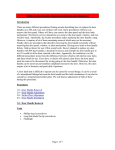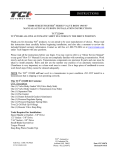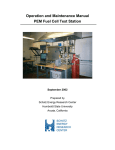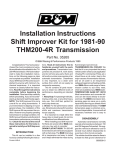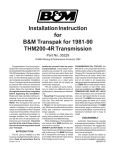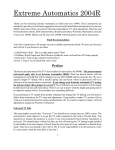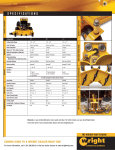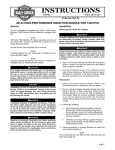Download chapter nine diagnosis and testing
Transcript
CHAPTER NINE DIAGNOSIS AND TESTING Introduction This section is intended to provide a practical method of identifying a specific transmission malfunction, followed by a sequential diagnostic procedure designed to lead the technician to the possible system or component responsible for the malfunction. Wherever possible, specific information regarding the in car inspection and replacement of a possible malfunctioning or damaged component is covered, allowing the technician to make the necessary repairs without removing the transmission from the vehicle. In the event that the conclusion of the diagnostic procedure dictates the transmission is to be removed from the vehicle for service, a list of possible internal components that may be responsible for the malfunction is included to assist the technician in quickly identifying the faulty component. It is recommended that entry level transmission technicians and seasoned professionals alike follow make the preliminary checks and adjustments prior to performing the hydraulic system pressure checks. It is recommended that entry level transmission technicians and seasoned professionals alike follow make the preliminary checks and adjustments prior to performing the hydraulic system pressure checks. There are a myriad of transmission malfunctions that can occur due to assembly errors and incompatibility of interchanged components. The most common transmission malfunctions and their most logical origins are covered in this section. The use of the Clutch and Band Application chart below will help the technician identify the hydraulic circuit and friction element and/or one way clutch associated with the particular operating range in which the malfunction occurs. AMC/JEEP Checking Transmission Oil Level and Condition The fluid level indicator, also known as the dipstick, is located in the filler pipe at the right rear of the engine. See Figures. GM GM Always check the oil level at normal operating temperature (190 degrees F), which is obtained after at least 10 miles of expressway or equivalent city driving. Automatic transmissions are frequently overfilled because the fluid level is checked when the fluid is cold and the fluid level indicator shows a low fluid level. When the fluid is cold the low fluid level indication is actually correct. A .750” rise in the fluid level shown on the indicator occurs as the fluid temperature rises from 65 to 190. See Figure. GM Situate the vehicle on a flat surface with the parking brake applied, the selector lever in the Park position, and the engine running. Remove the dipstick and cautiously touch the gage end to verify the transmission is at operating temperature. At normal operating temperature, the oil will heat the gage end of the dipstick to a degree where the average person can not grasp it firmly with his bare hand without discomfort. Wipe the gage end clean and reinsert the dipstick into the filler tube until the cap is seated flush with the top of the tube. Remove the dipstick and note the oil level. The oil level should be between the ADD and FULL marks. See Figure. GM If necessary, add or remove fluid to maintain the proper level. To bring the fluid level from the ADD mark to the FULL mark requires one pint. Do not overfill the transmission, as this will cause foaming and loss of oil through the vent pipe as the fluid heats up. Note that if the fluid level is too low, especially when cold, complete loss of movement can result. Examine the condition of the oil. Based on its condition, certain assumptions can be made. Years ago, when transmission fluid became dark it was an indicator of fluid or friction element failure. To some extent, this no longer holds true. Dexron II turns dark and takes on a definitive odor early in its life, so do not assume the fluid or transmission require replacement based on the color or smell of the fluid alone. If the oil appears clean or slightly discolored, but is transparent, this condition may be indicative of the possibility that no friction material damage has occurred. In such cases, an in car repair or service may be performed to correct the problem without requiring transmission removal from the vehicle. The presence of discoloration and non-transparency of the fluid along with a scorched odor usually indicate burnt fluid and friction elements which will require transmission removal from the vehicle to remedy. A satisfactory determination can be made after the appropriate tests have been performed and the results of these tests are carefully reviewed. Checking Manual Linkage The transmission manual linkage must be adjusted so that the pointer on the indicator quadrant and linkage detents or stops correspond with the transmission inside detent lever detents. If the linkage is not adjusted properly, an internal leak could occur at the manual valve which could cause a clutch and/or band to slip. Refer to the car division shop manual for manual linkage adjustment procedure. If a manual linkage adjustment is made (models 1964 thru 1969), the associated neutral safety switch should be adjusted, if necessary. The neutral safety switch should be adjusted so that the engine will start in the Park and Neutral positions only. With the selector lever in the Park position, the parking pawl should freely engage and prevent the vehicle from rolling. Note that quadrant labeling of Intermediate and Low Range varies between manufacturers. Note that 1964 model year TH400 have only five detent positions. These are “P”, “R”, “N”, “D”, and “L”. Checking Downshift Switch Do not put off inspecting the downshift switch until after the oil pressure testing is complete. The function of the switch can be checked relatively quickly and there are many issues that can arise due to a malfunctioning or defective downshift switch. The downshift switch will be attached to either the carburetor or gas pedal. The downshift switch is an on and off switch used to route a 12 volt power source to energize the detent solenoid @ wide open throttle, which then causes the detent valvetrain to upshift. This results in a fixed upshift schedule, calibrated to delay upshifts until relatively high vehicle speeds. Most common malfunctions encountered with the downshift switch that result in major drivability concerns are the result of a shorted out switch which constantly energizes the detent solenoid. In the event that the downshift switch does not energize the detent solenoid @ wide open throttle the transmission may exhibit no operational malfunctions other than no wide open throttle detents or no passing gear @ wide open throttle. The 12 volt power source from the downshift switch to the detent solenoid attaches to the case connector on the drivers side of the transmission. With the ignition key on and the engine off, remove the vehicle wiring from the case connector and probe the harness connector with a test light. There should be no voltage present at the connector. Have an assistant slowly open the throttle to wide open throttle. As wide open throttle is approached, the test light should illuminate indicating the presence of 12 volts at the harness connector. If a discrepancy exists, inspect the downshift switch and circuitry and make the necessary corrections. Note that with the throttle wide open, and the downshift switch energized, the technician should be able to push the plunger into the body of the switch far enough to result in a .050” gap between the throttle lever and the plunger. This keeps the plunger from bottoming out in the switch body which can result in damage to the switch. NOTE: If there is no voltage present at the connector and the transmission has been transplanted in the vehicle, there are aftermarket sources for universal detent switch assemblies for the TH400. In such cases, if the malfunction is anything other than no wide open throttle detents or no passing gear @ wide open throttle, continue with your testing. Vehicle performance will suffer without a functioning wide open throttle detent circuit. GM GM VARIOUS CASE CONNECTORS USED WITH THE TH400 GM Note that with 1987 and later model trucks, the ECM was given control over the detent solenoid. See the accompanying diagrams. DIAGRAMS FOR ECM CONTROL OF DETENT SOLENOID GM Checking Stator Switch-Variable Pitch Models Only 1965 to 1967 Oldsmobile and Cadillac vehicles equipt with the variable pitch stator option are equipt with a combined stator/detent switch. On Oldsmobile models the switch is located at the firewall of the engine compartment. On Cadillac models the switch is at the carburetor. Buick models use a separate micro-switch to control the stator “idle” position located at the firewall in the engine compartment and a combined stator/detent switch at the carburetor for moderate to heavy throttle activation. The stator switch is an on and off switch used to route a 12 volt power source to energize the stator solenoid when the engine is at idle or any throttle position above approximately half throttle which then causes the stator valve to upshift. When the stator valve upshifts, it exhausts oil from the variable stator piston, causing the stator blades to move on their pins to the high angle position. This results in increased torque multiplication acting on the transmission turbine shaft. When the solenoid is de-energized, the stator valve downshifts allowing oil pressure to act on the stator piston, causing the stator blades to move on their pins to the low angle position. This results in decreased torque multiplication acting on the transmission turbine shaft. The 12 volt power source from the stator switch or stator switch/micro-switch combination to the stator solenoid attaches to the case connector on the drivers side of the transmission. With the ignition key on and the engine off, remove the vehicle wiring from the case connector and probe the harness connector with a test light. There should be voltage present at the connector. Have an assistant slowly open the throttle. As the throttle begins to open just above idle, the test light should go out, and as half throttle is approached, the test light should illuminate and remain illuminated as full throttle is reached, indicating the presence of 12 volts at the harness connector. If a discrepancy exists, inspect the stator switch and circuitry and make the necessary corrections. GM Performing the Road Test As previously mentioned, always verify proper transmission oil level, manual linkage adjustment, and downshift switch operation before performing a road test. In cold weather allow adequate time for transmission warm up, assuring proper oil flow. Drive Range Position the selector lever in Drive range and accelerate the vehicle from 0 MPH. A 1-2 and 2-3 shift should occur at all throttle openings. The shift points will vary with the throttle position. As the vehicle decreases in speed to 0 MPH, the 3-2 and 21 shifts should occur. Low 2 Range Position the selector lever in Low 2 range and accelerate the vehicle from 0 MPH. A 1-2 shift should occur at all throttle openings. No 2-3 shift can be obtained in this range. The 1-2 shift point will vary with throttle position. As the vehicle decreases in speed to 0 MPH, a 2-1 shift should occur. Note the 1-2 shift in Low 2 range is somewhat firmer than in Drive range. This is normal. Low Range Position the selector lever in Low range and accelerate the vehicle from 0 MPH. No upshift should occur in this range, except possibly in some vehicles which have a high numerical final drive ratio and/or engine RPM. Low 2 Range-Overrun Braking Position the selector lever in the Drive range, and with the vehicle speed at approximately 35 MPH, with closed or 0 throttle, move the selector lever to the Low 2 range. The transmission should downshift to second gear. An increase in engine RPM and an engine braking effect should be noticed. Line pressure should change from approximately 70 PSI to approximately 150 PSI in Low 2 range. Low Range-Overrun Braking Position the selector lever in the Low 2 range, and with the vehicle speed at approximately 30 to 40 MPH, with throttle closed, move the selector lever to the Low range. The transmission should downshift to first gear in the speed range of approximately 40 to 20 MPH, depending on final drive ratio and valve body calibration. The 2-1 downshift at closed throttle will be accompanied by increased engine RPM and an engine braking effect should be noticed. Line pressure should be approximately 150 PSI. Stop Vehicle. Reverse Range Position the selector lever in the Reverse range and check the reverse operation. Shift Speed Specifications As previously stated, shift points will and should vary with throttle position, and each transmission is calibrated for a specific vehicle, engine, and final drive ratio. The following figures will provide some insight into the calibrated shift schedule for the given vehicle. The specifications in the figure below are for 1988 Jaguar vehicles with 3.31 and 3.07 final drive ratios. Note that these specs are very similar to those encountered with most mid 1970’s GM passenger cars. JAGUAR Hydraulic System Pressure Testing After the road test has verified that a problem exists, a pressure gage with a maximum capacity of 300 psi should be installed and the necessary oil pressure checks performed. A line pressure outlet is provided on the driver side of the transmission case. Attach a line pressure gage to the transmission as shown in the figure. Perform the oil pressure test as outlined and record the minimum and maximum values for comparison with the chart. GM Bring the engine and transmission up to operating temperature before taking oil pressure readings. Oil pressure readings will be slightly higher if the transmission has not been warmed up, usually in the range of some 15 psi. Minimum line pressures are obtained with the engine at 1000 rpm and the brakes applied. Maximum line pressures are obtained with the engine at 1000 rpm, the vacuum line to the modulator removed and plugged and the brakes applied. Hydraulic Pressure Test Specifications RANGE MINIMUM MAXIMUM PARK OR NEUTRAL REVERSE DRIVE LOW 2 LOW 1 60-90 95-150 60-90 135-150 135-150 165-170 260 165-170 165-170 165-170 If the hydraulic pressure test reveals high or low oil pressure in all ranges, the cause of the problem must be found before attempting any further diagnosis. Proceed directly to “Oil Pressure High All Ranges” or Oil Pressure Low All Ranges. Additional Pressure Tests If oil pressure values are satisfactory and the complaint is soft manual or automatic 1-2 and/or 2-3 upshift(s), or a slip or delay during the upshift(s), an additional test should be performed while operating the vehicle. While accelerating under various throttle positions, light to heavy, note the pressure drop on the gage during the shift. If the oil pressure drops more than 25 psi during the shift, inspect the oil filter, oil filter o-ring seal, the intake pipe and verify the correct oil pan/filter combination is in use. If no discrepancies are found, replace the filter and repeat test. GM As previously mentioned a function of governor pressure is to decrease modulator pressure and therefore mainline pressure during cruise speeds for improved shift quality and operating efficiency. This is also known as governor pressure “cutback”. A pressure test to verify the governor circuit is performing this function will also eliminate the governor assembly from being responsible for various malfunctions encountered with the governors regulating valve. These malfunctions include but are not limited to: no upshift, late upshift, second gear start, third gear start. With the selector lever in the Drive range, slowly accelerate from a stop while maintaining steady throttle pressure and noting the pressure value on the gage. As speeds above thirty mph are approached, there should be a slow and slight decrease in line pressure of approximately 10 to 20 psi. If the pressure fails to decrease, perform an inspection and servicing of the governor assembly as outlined in the technical service manual. Note that some shift recalibration kits remove the cutback function from the transmission when installed. When cutback is deleted, it requires that two flats be ground into the large lands of the modulator valve to exhaust any oil crossleaked oil into the cutback cavity. If pressure cutback does not occur, but the transmission shift schedule is correct, remove and inspect the modulator valve for presence of cutback land modification. Important Information Regarding Oil Pressure Test Results Be aware that the hydraulic pressure test specifications in the chart are based on OEM components. If the engine is fitted with a camshaft with increased duration it will produce reduced vacuum at idle, resulting in increases in the minimum oil pressure values. This will not result in increased maximum pressure values. Most transmissions fitted with aftermarket full manual control valve bodies do not use a vacuum modulator assembly to control line pressure. These transmissions use what is known as a fixed line pressure. This means that the oil pressure is the same in all ranges and the oil pressure gage reading will reflect this. Typical fixed pressure values are between 180 and 225 psi in all ranges, however; there are some exceptions. Due to the absence of adequate oil pressure in reverse, transmissions equipt with either BTE or TCI iron transmission brake valve bodies should only be operated in a reverse direction after the transmission brake has been activated in the Neutral position. When performing a pressure test with such valve bodies, values will be extremely low in the reverse range and this should be considered normal. The Winters Performance cast iron reverse pattern full manual valve body uses forward clutch apply oil to boost line pressure. Because forward clutch apply oil is only used in the forward ranges, it will only boost pressure in these ranges. In reverse, reverse oil is sent to the large land of the boost valve to increase system pressure, but will only result in approximately 135 psi. This is because there is no oil acting on the small land of the boost valve, and the reverse oil is acting in both directions limiting boost valve force on the pressure regulator valve. Transmission brake equipt or high rpm units with a .055” to .067” oil bleed in the direct clutch housing will typically show a drop of up to 7 psi when operated in reverse or high gear due to the leak. This is normal. When in doubt, consult with the manufacturer regarding the pressure value information specific to the design. The minimum oil pressure values on transbrake equipt transmissions with the transmission brake applied is 170 psi. This is to avoid friction element slip which can result in the inability of the transmission brake to remain applied against the engines torque load being imparted on the transmissions turbine shaft. On models equipt with certain transmission brakes oil pressure may drop up to 20 psi during application of the transmission brake. If this occurs, bring engine up to 1500 rpm and note pressure values on the gage. If the pressure value remains low by 20 psi or more, it is advisable to make changes to the pressure regulator spring to increase the oil pressure value achieved with the transmission brake applied. If the pressure increase results in line pressures values over 220 psi when the transmission brake is not applied, you should consult the manufacturer. Oil Pressure High All Ranges Most engagement, shift quality and shift timing concerns encountered in the field are the result of high hydraulic system pressure in all ranges as the result of a weak or non-existent vacuum signal being received by the vacuum modulator. Always begin diagnosis by verifying that the plumbing between the intake manifold and modulator is attached properly and securely. Verify the plumbing is not cut, plugged, pinched or restricted. Check for carbon buildup at the intake manifold to modulator line vacuum fitting. Make necessary corrections; recheck oil pressure, and road test. If pressure remains high, continue. GM Install a vacuum gage in series between the intake manifold and the vacuum modulator. Start the engine. Bring the engine up to operating temperature and idle with the transmission in Park. Note vacuum values on the gage. The gage should read between 15-22 in. Hg. The gage should respond instantly to throttle movement. If vacuum signal values are within the specifications, proceed to Vacuum Modulator and Modulator Valve Check. If vacuum value is low, and/or the gage does not respond instantly to throttle movement, the engine state of tune etc. must be checked and corrected so that proper vacuum values are restored. An additional check may be made at this time to confirm that low vacuum is in fact the cause of the high oil pressure. Remove and plug the vacuum line from the modulator, and securely attach a hand held vacuum pump to the modulator. Raise and lower the vacuum to the modulator. The oil pressure should raise (decreasing vacuum) and fall with (increasing vacuum) smoothly. Compare minimum and maximum line pressure values to specifications. If pressure values are within specifications, this confirms a weak vacuum signal is being received by the vacuum modulator assembly. Make necessary corrections, check oil pressure, and road test. If oil pressure values remain high, proceed to Vacuum Modulator and Modulator Valve Checks. GM GM GM Vacuum Modulator and Modulator Valve Checks Hydra-Matic performed an inspection of modulator assemblies replaced in the field. The inspection uncovered that over 50% of the parts returned as defective were good. For this reason, the following procedures are recommended for checking modulator assemblies in the field before replacement. The Vacuum Modulator and Modulator Valve are located at the passenger side front of the transmission. When performing the checks outlined in this section, never start the engine with either item removed from the transmission. GM GM Vacuum Diaphragm Leak Check Check for the presence of transmission fluid in the modulator assembly by inserting a pipe cleaner into the modulator vacuum connector as far as possible. Withdraw the pipe cleaner and inspect it for the presence of any transmission fluid. If fluid is present in the connector pipe, it is an indicator of a damaged diaphragm, necessitating modulator replacement. Transmission fluid lost thru the diaphragm can be drawn into the intake manifold and burned by the engine. This will result in low transmission oil level, and the emission of white smoke from the vehicles exhaust system. If no oil is found in the vacuum side of the modulator but the transmission oil level is continuously low, and no external leaks are found, there is a possibility that a pin hole exists in the diaphragm and the modulator should be replaced. Note that gasoline or water condensation may settle in the vacuum side of the modulator. Check the solution that comes out of the modulator for lubricity. If the solution does not have the feeling of oiliness it can be assumed that the solution is a mix of gas and/or water. If condensation is found without the presence of transmission fluid, replacement of the modulator is not necessary. Vacuum Diaphragm Holding Check Test the holding ability of the vacuum diaphragm. Securely attach a hand held vacuum pump to the modulator. Apply 20 inches vacuum, and note the gage. Vacuum should not drop for at least 30 seconds. If a bleed down occurs, a vacuum leak is indicated, necessitating modulator replacement. Before replacing the modulator, verify the bleed down is not a result of a poor connection between the hand held vacuum pump and the modulator. Hold a finger firmly against the end of the hose and apply 20 inches vacuum. Vacuum should not drop for at least 30 seconds. If a bleed down occurs, tooling is faulty. AMC/JEEP Atmospheric Leak Check Apply a liberal coating of soap bubble solution to the vacuum connector pipe seam, the crimped upper to lower housing seam, and the threaded screw seal. Using a short piece of rubber tubing, apply air pressure to the vacuum pipe. Blow into the tube and check for bubbling of the solution. If bubbles appear, replace the modulator. Do not use any method other than human lung power for applying air pressure, as pressures over 6 PSI may damage the modulator. GM Vacuum Modulator Runout Check Inspect the modulator for obvious signs of external damage, dents and cracks. Roll the modulator back and forth on a flat surface to determine if the sleeve is concentric to the can. If the sleeve is bent, runout will be visible, necessitating modulator replacement. GM GM Vacuum Modulator Plunger Travel Check Attach a hand held vacuum pump to the modulator. Slowly apply a maximum of 21 inches vacuum and note when modulator plunger travel begins and ends. Depending on modulator type, travel should begin and end between 16 and 21 or 12 and 16 inches of vacuum. Plunger should move freely in and out of the cylinder as vacuum is applied and released. Total plunger travel is approximately .300”. If the plunger binds in the cylinder, replace the modulator. Apply 20 inches vacuum. At this vacuum level, the distance from the end of the plunger cylinder to the end of the plunger should measure 5/8 inch. If full travel is not reached, replace the modulator. GM Vacuum Modulator Bellows Comparison Check Use a modulator bellows comparison gage to compare the load of a good known vacuum modulator assembly with the one in question. If an OEM comparison gage is not available, on may be fabricated using the figure below. GM Insert one end of the comparison gage into the suspected modulator sleeve. Insert the opposite end of the gage into a known good modulator of the same part number as the suspected modulator. The part number of the modulator assembly is located on the back side of the modulator. Holding the modulators in a horizontal position, slowly bring them together under pressure. The modulator in question, if bad, will reach the centerline of the comparison gage before the known good modulator. GM If the modulator in question is good, the centerline of the comparison gage will be approximately midway between both modulators. GM In the absence of a modulator bellows comparison gage, a similar check can be performed. Push on the plunger of the modulator in question with a screwdriver while monitoring required force to generate movement. Perform this same check on a known good modulator of the same part number. If the modulator in question is defective, it will offer much less resistance. GM If modulator is found to be defective, perform replacement, check oil level, check oil pressure, and road test. If the modulator has passed all of the previous checks, it is an acceptable part and should be re-used. Proceed to Vacuum Modulator Valve Check. Vacuum Modulator Valve Check The vacuum modulator valve should operate smoothly in and out of the case bore. The valve and bore should be free of nicks, scoring, or any other damage. If the valve does not operate smoothly, make the necessary corrections; check oil pressure, and road test. If pressure values are not within the specifications, proceed to Pressure Regulator Check. GM Pressure Regulator Assembly Check The Pressure Regulator Assembly is located in a bore in the oil pump cover at the driver side front of the transmission. It is accessed by removal of the transmission oil pan and filter assembly. Fabricate a removal/installation tool using the figure. If tool is not available, compress the valve against spring tension with a steel rod. GM The pressure regulator spring is tightly compressed and will force the boost valve assembly out of the bore when the snap ring is removed. During removal, keep pressure on the assembly and release it slowly out of the bore. AMC/JEEP The pressure regulator valve should operate smoothly in and out of the pump bore, as should the boost valve in and out of the sleeve bore. Both the valves and the bores should be free of nicks, scoring, or any other damage. The spring should be free of damage and the spacer(s) correctly positioned. If any discrepancies are found, make the necessary corrections; check oil pressure, and road test. GM If no discrepancies are found, it can be assumed that a hydraulic system crossleak exists. Using the procedures outlined in the technical service manual, remove and inspect the valve body, separator plate and gaskets. If no discrepancies are found remove and inspect the oil pump. Oil Pressure Low All Ranges Perform the following checks from “Oil Pressure High All Ranges”: Vacuum Modulator Valve Check Pressure Regulator Assembly Check In Vehicle Checks Oil Filter Oil Filter O-Ring Seal Intake Pipe Oil Pan and Filter Combination Inspect Valve Body, Separator Plate, and Gaskets for Improper Torque, Mispositioning or Damage Bench Checks Oil Pump Assembly No Park or Will Not Release from Park In Vehicle Checks Inspect Parking Linkage Assembly No Detent Downshifts Oil Pressure Normal In Vehicle Checks Detent Solenoid Detent Valvetrain Inspect Valve Body, Separator Plate, and Gaskets for Improper Torque, Mispositioning or Damage No Part Throttle 3-2 Downshifts Oil Pressure Normal In Vehicle Checks 3-2 Valve Inspect Valve Body, Separator Plate, and Gaskets for Improper Torque, Mispositioning or Damage No Reverse or Slips in Reverse Oil Pressure Low in Reverse Oil Pressure Low in Reverse and Manual Low In Vehicle Checks Check Case for Presence of Low Reverse Check Ball Air Check Direct Clutch Housing-Listen for Excessive Leakage Air Check Rear Servo Assembly- Listen for Excessive Leakage Inspect Rear Servo Assembly for Damaged Seals Inspect Valve Body, Separator Plate, and Gaskets for Improper Torque, Mispositioning or Damage Bench Checks Inspect Direct Clutch Housing for Leaking or Damaged Seals Inspect Center Support for Damaged Oil Seal Rings or Seal Ring Grooves Note that leaks encountered at the rear servo assembly will usually result in the loss of engine braking in the Low Range. No Reverse or Slips in Reverse Oil Pressure Normal In Vehicle Checks Air Check Rear Servo Assembly-Verify Piston Stroke Inspect Rear Servo Assembly for Damage Perform Rear Servo Apply Pin Length Check Valve Body-Inspect for Stuck or Sticking 2-3 Shift Valve Case Servo Feed Cup Plug (Some Models)-Restricted Inspect Valve Body, Separator Plate, and Gaskets for Improper Torque, Mispositioning or Damage Bench Checks Inspect the Rear Band Inspect the Direct Clutch Housing Inspect the Forward Clutch Assembly Note that a forward clutch that does not release will result in no reverse and will cause a drive condition in Neutral. Note that a stuck open 2-3 shift valve will also result in a 1-3 upshift in the Drive Range. No Drive or Slips in All Drive Ranges Oil Pressure Low in All Drive Ranges In Vehicle Checks Air Check Forward Clutch Housing-Listen for Excessive Leakage Inspect Valve Body, Separator Plate, and Gaskets for Improper Torque, Mispositioning, Damage Bench Checks Inspect Forward Clutch Housing for Leaking or Damaged Seals Inspect Oil Pump for Damaged Oil Seal Rings or Seal Ring Grooves No Drive or Slips in Drive Oil Pressure Normal In Vehicle Checks Manual Valve Disconnected from Manual Lever Pin Inspect Valve Body, Separator Plate, and Gaskets for Improper Torque, Mispositioning or Damage Bench Checks Low One Way Clutch Assembly Forward Clutch Assembly Forward Clutch Hub Mainshaft Note that a malfunction or failure with any of the components on the list will also result in a condition of No Drive or Slipping in Low 2-First Gear Range. If drive is restored when placing the selector lever in the Low Range, there is a malfunction with the low one way clutch assembly. Late or No 1-2 and 2-3 Upshifts In Vehicle Checks Governor Screen-Restricted or Plugged. Inspect Valve Body, Separator Plate, and Gaskets for Improper Torque, Mispositioning or Damage No Second or Soft/Slipping 1-2 Upshift Oil Pressure Low in Drive Range-Second Gear, Drive Range-Third Gear, and Low 2 Range-Second Gear Only In Vehicle Checks Inspect Case to Center Support Bolt for Damage/Proper Torque Air Check Intermediate Clutch-Listen for Excessive Leakage Inspect Valve Body, Separator Plate, and Gaskets for Improper Torque, Mispositioning or Damage Bench Checks Inspect Intermediate Clutch Piston for Leaking or Damaged Seals Inspect Transmission Case for Leaking or Missing Intermediate Clutch Cup Plug No Second or Soft/Slipping 1-2 Upshift Oil Pressure Normal In Vehicle Checks Inspect Case to Center Support Bolt for Damage/Proper Torque Inspect 1-2 Shift Valvetrain and 1-2 Accumulator Valvetrain in Valve Body Inspect the Rear Accumulator Assembly Inspect Valve Body, Separator Plate, and Gaskets for Improper Torque, Mispositioning or Damage Bench Checks Inspect Intermediate Clutch Assembly Inspect the Intermediate One Way Clutch Assembly Harsh 1-2 Upshift Oil Pressure Normal In Vehicle Checks Inspect 1-2 Accumulator Valvetrain in Valve Body Inspect Rear Accumulator Assembly Inspect Valve Body, Separator Plate, and Gaskets for Improper Torque, Mispositioning or Damage Bench Checks Intermediate Clutch Assembly No Third or Soft/Slipping 2-3 Upshift Oil Pressure Low in Drive Range-Third Gear and Only In Vehicle Checks Inspect 2-3 Accumulator Assembly Air Check Direct Clutch Housing-Listen for Excessive Leakage Inspect Valve Body, Separator Plate, and Gaskets for Improper Torque, Mispositioning or Damage Bench Checks Inspect Direct Clutch Housing for Leaking or Damaged Seals Inspect Center Support for Damaged Oil Seal Rings or Seal Ring Grooves No Third or Soft/Slipping 2-3 Upshift Oil Pressure Normal In Vehicle Checks Inspect 2-3 Accumulator Assembly Inspect 2-3 Shift Valvetrain Inspect Valve Body, Separator Plate, and Gaskets for Improper Torque, Mispositioning or Damage Bench Checks Inspect Direct Clutch Assembly Harsh 2-3 Upshift Oil Pressure Normal In Vehicle Checks Inspect 2-3 Accumulator Assembly Inspect Valve Body, Separator Plate, and Gaskets for Improper Torque, Mispositioning or Damage Bench Checks Direct Clutch Assembly Direct Clutch Wave or Dish Plate No Engine Braking in Low Range-First Gear Oil Pressure Normal, Oil Pressure Low in both Manual Low and Reverse In Vehicle Checks Check Case for Presence of Low Reverse Check Ball Air Check Rear Servo Assembly Inspect Rear Servo Assembly Bench Checks Rear Band Reaction Carrier Drum Surface Case Band Anchor Pins Note that a missing low reverse checkball will result in low oil pressure in both the Low and Reverse Ranges. Note that issues encountered with the rear servo assembly will usually result in the loss of reverse or slipping in the Reverse Range. No Engine Braking in Intermediate Range-Second Gear Oil Pressure Normal In Vehicle Checks Front Servo Assembly Mismatched Servo/Accumulator Parts Front Accumulator Piston Bench Checks Front Band Case Band Anchor Pin Transmission Noise Noise believed to be emanating from the transmission is sometimes found to be caused by a damaged or defective alternator, water pump, power steering pump, A.I.R. pump, air conditioning compressor, loose torque converter to flexplate bolts or a cracked or broken flexplate. This is especially true when the complaint is not accompanied by a drivability complaint, satisfactory oil pressure values are found, and the noise condition is also met when the vehicle is not in motion. Transmission noise in the form of oil pump cavitation and pressure regulator assembly business caused by a low oil level is commonplace. This is especially true when the complaint is accompanied by a drivability issue and the noise condition is more pronounced with the selector lever in the Reverse, Low or Low 2 ranges. Be sure to check and adjust oil level prior to attempting any diagnosis. Cavitation related noise almost always results in poor hydraulic system pressure values. For this reason, always perform proper hydraulic system checks prior to diagnosing a possible cavitation related noise issue. GM Noise Present in All Ranges In Vehicle Checks for Noise Present in All Ranges Oil Filter Oil Filter O-Ring Seal Intake Pipe Oil Pan and Filter Combination Bench Checks for Noise Present in All Ranges Oil Pump Gears Oil Pump Body Oil Pump Cover Noise Present in First and/or Reverse Gears Only Bench Checks for Noise Present in First Gear Sun Gear Output Carrier Reaction Carrier Rear Internal Gear # 20 Thrust Bearing Assembly # 21 Thrust Bearing Assembly # 22 Thrust Bearing Assembly Noise Present in Second Gear Only Bench Checks for Noise Present in Second Gear Sun Gear Output Carrier Rear Internal Gear # 21 Thrust Bearing Assembly # 22 Thrust Bearing Assembly Torque Converter Stator Operation Diagnosis If the stator one way clutch becomes ineffective, the stator assembly will freewheel at all times in both directions. With this condition, the vehicle will tend to have poor acceleration from a standstill, and approaching speeds above 30 mph the vehicle may act normal. If poor acceleration problems are noted, it should first be determined that the exhaust system is not blocked, the engine is in good tune, and the transmission is in first gear when starting off. If the engine can accelerate to high rpm in neutral it can be assumed engine and exhaust system performance are satisfactory. Driving the vehicle in reverse and noting vehicle performance will help to determine if the stator is freewheeling. If the stator assembly remains locked up at all times, the engine rpm and vehicle speed will tend to be limited or restricted at high speeds. Vehicle performance when starting off from a dead stop will remain normal. This condition will sometimes result in torque converter and engine overheating. A visual inspection of the outside of the torque converter may reveal blueing of the shell due to overheating. In either case the, the transmission must be removed from the vehicle in order to perform a check of the stator one way clutch. Insert a finger into the splined inner race of the roller clutch, and attempt to turn the race in both directions. Under normal conditions the inner race should turn freely in the clockwise direction, but not turn or be very difficult to turn in the counter-clockwise direction. If any discrepancies are found, replace the torque converter. Do not use the pump cover/stator shaft to turn the race as the results can be misleading. No Stator Angle Change-Variable Pitch Models Only In Vehicle Checks Internal Wiring Harness to Case Connector Bench Checks Oil Pump-Stator Valvetrain Oil Pump-Downshift Solenoid Oil Pump-Reed Valve Missing Oil Pump-Turbine Shaft Oil Seal Ring Bore Turbine Shaft-Feed Circuit Restricted Turbine Shaft-Oil Seal Ring Transmission Case-Stator Orifice Plug Missing or Plugged Oil Leak Checking With the exception of an oil leak originating from the oil pump, torque converter, or an internal malfunction resulting in oil being pushed out the vent pipe, all possible leak points are usually serviceable with the transmission in the vehicle. Investigate to find the origin of the leak and inspect the component thought to be the cause. If no obvious signs of leakage are evident, clean the area and run the engine until the source of the leak is identified. Once the source of the leak is identified, make the necessary corrections using the procedures outlined in the technical service manual. Transmission Oil Pan Leaks Attaching bolts not correctly torqued. Improperly installed or damaged pan gasket. Oil pan damaged. Oil pan gasket mounting flange damaged/not flat. Extension Housing Leak Attaching bolts not correctly torqued Extension housing seal. Extension housing bushing. Slip yoke vent hole- output shaft o-ring seal missing or damaged. Extension housing to case gasket. Case Leak Filler pipe o-ring seal or boot damaged or missing. Modulator o-ring seal. Case connector o-ring seal. Governor cover gasket. Speedometer driven gear housing. Manual shaft seal. Line Pressure tap plug. Vent pipe. Porous case. Front End Leak Front seal. Pump to case o-ring seal. Pump attaching bolts loose or seal washers damaged. Converter leak at welds or drive hub. Oil Cooler Lines Connections at radiator loose or stripped. Connections at case loose or stripped. Oil Comes Out Vent Pipe Transmission over-filled. Water in oil. Warped pump body or pump cover. Checkball in forward clutch housing damaged or missing. Malfunctions Related to Missing or Mispositioned Checkballs #1 Checkball-Direct Clutch Harsh 3-2 downshift which can result in intermediate one way clutch failure. #2 Checkball-Front Servo Release Harsh 2-3 upshift. Harsh 3-2 downshift result which can result in intermediate one way clutch failure. #3 Checkball- Front Servo Apply Harsh 3-2 downshift result which can result in intermediate one way clutch failure. #4-Checkball-Intermediate Clutch Apply Harsh 1-2 upshift which can result in intermediate one way clutch failure. #5-Checkball-Intermediate Low oil pressure in Park, Reverse, Neutral, and Drive Range. Slipping in Reverse and Drive Range. #6 Checkball-Low and Reverse Low oil pressure in Low 1 and Reverse Range. No engine braking in Low 1 Range. No reverse or slips in Reverse Range. #7 Checkball- Reverse 1988 and up model years only. Harsh reverse engagement.


































